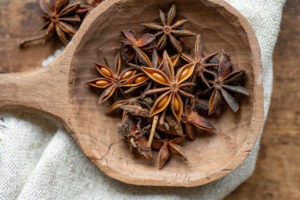As temperatures are dropping it’s the perfect time to experiment with an array of new and familiar spices to add warmth and flavor to dishes. Not only do the aromas make the kitchen more inviting, it also makes mealtimes more enjoyable.
Prized since ancient times, spices have been highly regarded for many reasons. They have been used for culinary, medicinal, and even religious purposes. Historically, spices have been traded across the world and have played a significant role in shaping the world’s economy and history. In ancient times, cinnamon was so highly prized as a currency that it was considered more valuable than gold.
 Financial measures aside, culinary recipes are perhaps the most well-known use of spices, which are made from dried seeds, fruits, bark, roots, or other plant materials. Their use can be deeply intertwined with the changing seasons and availability of fresh ingredients, but spices have always been used in ways to enhance the taste of food, primarily for flavoring, coloring and preserving food. Spices activate taste receptors resulting in five basic profiles: sweet, sour, bitter, salty, and umami.
Financial measures aside, culinary recipes are perhaps the most well-known use of spices, which are made from dried seeds, fruits, bark, roots, or other plant materials. Their use can be deeply intertwined with the changing seasons and availability of fresh ingredients, but spices have always been used in ways to enhance the taste of food, primarily for flavoring, coloring and preserving food. Spices activate taste receptors resulting in five basic profiles: sweet, sour, bitter, salty, and umami.
Spices like nutmeg, cinnamon and cardamom add warmth and depth to sweet dishes. While savory spices like cumin, coriander, and paprika give a unique flavor and aroma to meats, stews, and soups. Black pepper, cumin and mustard seed are known for their pungency and are most often used in savory cooking, and many spices have medicinal benefits as well. For instance, adding mustard seeds to cooked broccoli has been shown to enhance the absorption of sulforaphanes (sulforaphanes have been found to have numerous health benefits, including anti-inflammatory and antioxidant effects, as well as the ability to support the body’s detoxification pathways.)
Regardless of their purpoted health benefits, spices have played a significant role in shaping cultural culinary traditions throughout history and across the globe. Certain countries and cultures are recognized for their use of specific spices to enhance the flavors and aromas in traditional dishes. India relies on a variety of spices such as turmeric, cumin, and ginger for both their flavoring and medicinal benefits in dishes like curry. Chinese cuisine incorporates star anise and Sichuan pepper in popular dishes like hot pot and Kung Pao chicken. Latin American cuisine is known for its bold and flavorful spices that add depth and complexity, such as, cumin, chili powder, oregano, garlic, and paprika, while Italian cuisine relies heavily on basil, oregano, rosemary, parsley, and thyme.
 Owner Rosmery Serva and her team at Saffron bring dishes from India to the Ketchum restaurant and are not afraid to experiment by adding paprika to certain curries to give them a pleasant red hue and aroma, deviating from traditional preparation methods. Paprika is not commonly used in Indian dishes due to the preference for heat. Saffron’s curries are characterized by a family Garam Masala recipe, which relies heavily on that signature ingredient in all the curries made.
Owner Rosmery Serva and her team at Saffron bring dishes from India to the Ketchum restaurant and are not afraid to experiment by adding paprika to certain curries to give them a pleasant red hue and aroma, deviating from traditional preparation methods. Paprika is not commonly used in Indian dishes due to the preference for heat. Saffron’s curries are characterized by a family Garam Masala recipe, which relies heavily on that signature ingredient in all the curries made.
Some spices are used year-round, while others are reserved for specific seasons and benefits. Andreas Heaphy, renowned chef at Rickshaw in Ketchum, knows this all too well. He loves to add extra Thai chilies and dried Japone chilies to his signature dishesas winter approaches, using them to turn up the heat. One of his favorite spices is Sichuan Peppercorn, which he was first introduced to while dining at Sichuan Gourmet Restaurant in New York City. He loves the unique tingling sensation the peppercorns provide and uses them to make the oil for his udon noodle dish.
Just like a chef, try experimenting with different spice combinations to bring cultures together and create new and exciting flavors that match the season and will warm things up this winter. It will not only enhance the flavor of meals, but will also bring a bit of adventure into the kitchen!
Common Spices & their Flavor Profiles
CINNAMON: sweet, warm, and slightly spicy
CLOVES: sweet and aromatic with a hint of bitterness
CUMIN: earthy, nutty, and slightly bitter
PAPRIKA: slightly sweet and smoky
GINGER: spicy, warm, and slightly sweet
TURMERIC: slightly earthy and bitter with a hint of sweetness
CORIANDER: citrusy, slightly sweet, and earthy
GREEN CARDAMOM: sweet, spicy, and floral
NUTMEG: sweet, nutty, and slightly spicy
BLACK PEPPER: spicy and slightly pungent
Green and Black Cardamom
Cardamom is popular in winter months. Most commonly used is green cardamom. Lesser known is black cardamom. They look different and are also different in terms of flavor, aroma, and uses. Green cardamom is commonly added to sweet dishes like desserts and warm holiday drinks. Black cardamom provides a strong, smoky flavor in savory dishes like curries, stews, and chilis.
Want to take your bean game to the next level? Simply toss a black cardamom pod into a pot of beans while they are cooking, it’ll add a smoky, earthy flavor and will complement the natural sweetness of the beans. The black cardamom pods are best when added whole to a recipe and removed before serving.
RECIPES
Kolkata Tandoori Masala From Ratnadeep Chakraborty, Owner of Saffron, Ketchum (This is my mom’s recipe in Kolkata where I am from)
1 Tablespoon Cumin powder
1 Tablespoon Coriander powder
½ teaspoon Chaat masala
½ teaspoon Chili powder
½ teaspoon Fennel powder
1 Tablespoon Kitchen king masala
Mix all together in a bowl. For a marinade: Mix with 2 tbs mustard oil and 1⁄2 cup yogurt and garlic and ginger paste.
Pink Peppercorn Flatbreads
Despite their name, pink peppercorns are not actually true peppercorns but rather the dried fruit of a tree native to South America. Unlike black peppercorn they have a subtle sweetness with a hint of spice to them.
 1 cup chèvre cheese, room temperature
1 cup chèvre cheese, room temperature
1 teaspoon pink peppercorns, more for garnish
1 teaspoon lemon zest, more for garnish
1 teaspoon thyme leaves (fresh if possible), more for garnish
Flaky sea salt for garnish
Flatbread crackers
Place the chèvre in a bowl. Add the peppercorns to the bowl. Rub the peppercorns between your fingers to crush them as you sprinkle them over the chevre. Add lemon zest, thyme leaves, stir to combine. To serve, spread on to flatbread crackers, garnish with additional pink peppercorns, lemon zest, thyme leaves and flaky sea salt.
Cardamon Winter Lemonade By adding green cardamom to a basic hot lemonade, you can turn the drink into a fragrant and delightful experience for your senses. Serving size 1
1 teaspoon crushed green cardamom pods
1 teaspoon dried organic rose petals (optional)
Juice of one lemon
Honey to taste
In a pot over medium heat add water, cardamom pods and rose petals (if using). Warm over medium heat for about 15 minutes or until the cardamom is fragrant. Add the lemon juice, stir to combine. Strain into a mug, stir in honey to desired taste and serve immediately.
Cumin Orange Pecans
Cumin is an essential ingredient in many world cuisines, particularly in Mexican, Indian, and Middle Eastern cooking. Its adaptable flavor and various health benefits make it an ideal and easy spice to be used in a multitude of ways.
 2 tablespoons butter
2 tablespoons butter
2 cups pecans halves
2 teaspoon cumin seeds
2 teaspoon orange zest
½ teaspoon coarse salt
Pinch of cayenne pepper
2 tablespoons maple syrup
Flaky sea salt, to taste
In a skillet over medium heat add butter, once melted add pecans. Sprinkle cumin, orange zest, salt and pinch of cayenne over the pecans, stir for several minutes so the pecans do not burn. Add maple syrup. Continue cooking for about five minutes or until pecans are nice and brown. Be sure to continue stirring so the pecans do not burn. Remove from the heat, spread the pecans out on parchment paper, sprinkle with flaky sea salt, let them cool completely before enjoying.


